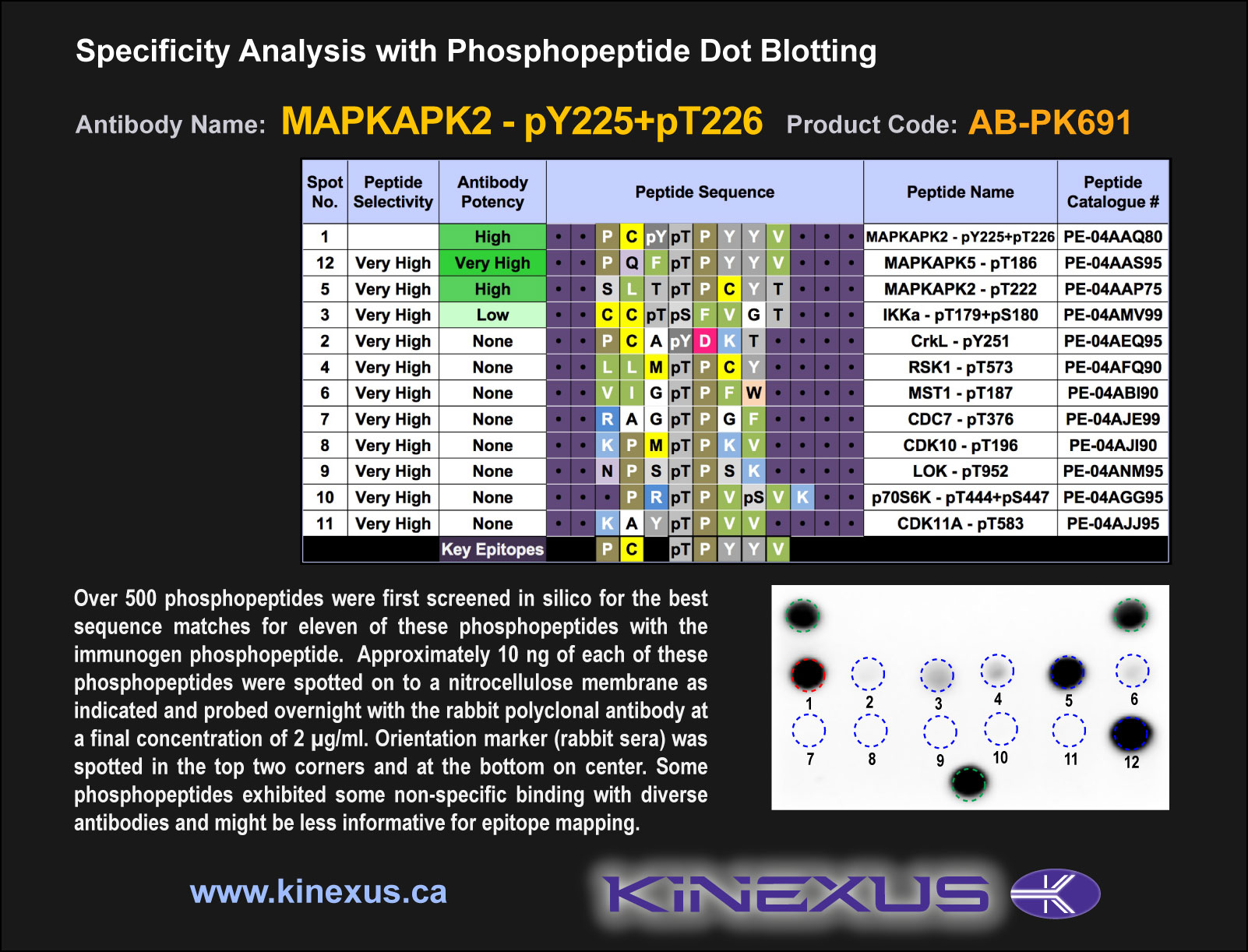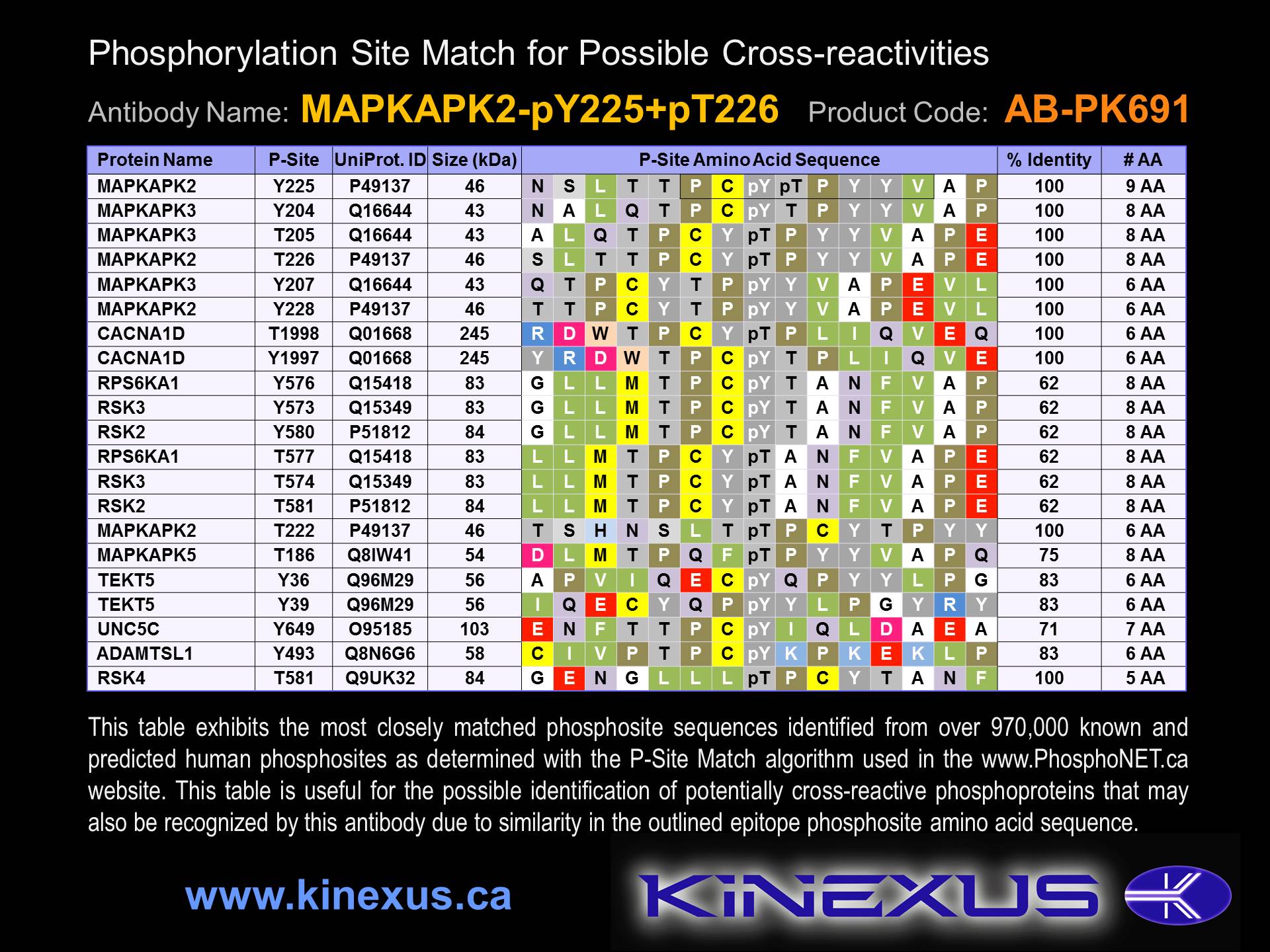Product Name: MAPKAPK2-pY225+pT226
Product Number: AB-PK691
| Size: | 25 µg | Price: | 89.00 | |
| $US |
Target Full Name: Mitogen-activated protein kinase-activated protein kinase 2
Target Alias: MAP kinase-activated protein kinase 2; MAPK2; MAPKAP kinase 2; MK2; RPS6KC1; ENSG00000162889
Product Type Specific: Protein kinase phosphosite-specific antibody
Antibody Code: PK691
Antibody Target Type: Phosphosite-specific
Antibody Phosphosite: Y225+T226
Protein UniProt: P49137
Protein SigNET: P49137
Antibody Type: Polyclonal
Antibody Host Species: Rabbit
Antibody Immunogen Source: Human MAPKAPK2 sequence peptide Cat. No.: PE-04AAQ80
Target Alias: MAP kinase-activated protein kinase 2; MAPK2; MAPKAP kinase 2; MK2; RPS6KC1; ENSG00000162889
Product Type Specific: Protein kinase phosphosite-specific antibody
Antibody Code: PK691
Antibody Target Type: Phosphosite-specific
Antibody Phosphosite: Y225+T226
Protein UniProt: P49137
Protein SigNET: P49137
Antibody Type: Polyclonal
Antibody Host Species: Rabbit
Antibody Immunogen Source: Human MAPKAPK2 sequence peptide Cat. No.: PE-04AAQ80
Antibody Immunogen Sequence: PC(pY)(pT)PYYV(bA)C
Antibody Immunogen Description: Corresponds to amino acid residues P223 to V230; In the protein kinase catalytic domain activation T loop region between subdomains VII and VIII.
Antibody Immunogen Description: Corresponds to amino acid residues P223 to V230; In the protein kinase catalytic domain activation T loop region between subdomains VII and VIII.
Production Method: The immunizing peptide was produced by solid phase synthesis on a multipep peptide synthesizer and purified by reverse-phase hplc chromatography. Purity was assessed by analytical hplc and the amino acid sequence confirmed by mass spectrometry analysis. This peptide was coupled to KLH prior to immunization into rabbits. New Zealand White rabbits were subcutaneously injected with KLH-coupled immunizing peptide every 4 weeks for 4 months. The sera from these animals was applied onto an agarose column to which the immunogen peptide was thio-linked. Antibody was eluted from the column with 0.1 M glycine, pH 2.5. Subsequently, the antibody solution was neutralized to pH 7.0 with saturated Tris.This antibody was also subject to negative purification over phosphotyrosine-agarose.
Antibody Modification: Unconjugated. Contact KInexus if you are interest in having the antibody biotinylated or coupled with fluorescent dyes.
Antibody Modification: Unconjugated. Contact KInexus if you are interest in having the antibody biotinylated or coupled with fluorescent dyes.
Antibody Concentration: 1 mg/ml
Storage Buffer: Phosphate buffered saline pH 7.4, 0.05% Thimerasol
Storage Conditions: For long term storage, keep frozen at -40°C or lower. Stock solution can be kept at +4°C for more than 3 months. Avoid repeated freeze-thaw cycles.
Product Use: Western blotting | Antibody microarray
Antibody Dilution Recommended: 2 µg/ml for immunoblotting
Antibody Potency: Medium immunoreactivity with immunogen peptide on dot blots.
Antibody Species Reactivity: Human
Antibody Positive Control: The observed molecular mass of the processed target protein on SDS-PAGE gels is reported to be around 48-53 kDa.
Storage Buffer: Phosphate buffered saline pH 7.4, 0.05% Thimerasol
Storage Conditions: For long term storage, keep frozen at -40°C or lower. Stock solution can be kept at +4°C for more than 3 months. Avoid repeated freeze-thaw cycles.
Product Use: Western blotting | Antibody microarray
Antibody Dilution Recommended: 2 µg/ml for immunoblotting
Antibody Potency: Medium immunoreactivity with immunogen peptide on dot blots.
Antibody Species Reactivity: Human
Antibody Positive Control: The observed molecular mass of the processed target protein on SDS-PAGE gels is reported to be around 48-53 kDa.
Related Product 1: MAPKAPK2-pY225+pT226 blocking peptide
Related Product 2: MAPKAPK2-pT222 phosphosite-specific antibody (Cat. No.: AB-PK690)
Related Product 3: MAPKAPK3-pY76 phosphosite-specific antibody (Cat. No.: AB-PK692)
Related Product 4: MAPKAPK5-pT186 phosphosite-specific antibody (Cat. No.: AB-PK693)
Related Product 5: HSP27 (81-86) KinSub - Based on Heat shock protein 27 (L81-S86, mouse) peptide; HSP27tide protein kinase substrate peptide
Related Product 6: MAPKAPK2Subtide - MAP3K15 protein kinase substrate peptide
Related Product 2: MAPKAPK2-pT222 phosphosite-specific antibody (Cat. No.: AB-PK690)
Related Product 3: MAPKAPK3-pY76 phosphosite-specific antibody (Cat. No.: AB-PK692)
Related Product 4: MAPKAPK5-pT186 phosphosite-specific antibody (Cat. No.: AB-PK693)
Related Product 5: HSP27 (81-86) KinSub - Based on Heat shock protein 27 (L81-S86, mouse) peptide; HSP27tide protein kinase substrate peptide
Related Product 6: MAPKAPK2Subtide - MAP3K15 protein kinase substrate peptide
Scientific Background: MAPKAPK2 is a protein-serine/threonine kinase that is a member of the CAMK group of protein kinases in the MAPKAPK family, and MAPKAPK subfamily. This kinase is highly expressed and widely distributed in most tested human tissues. It functions in the regulation of various cellular processes, including cytokine production, endocytosis, cytoskeletal reorganization, cell migration, cell cycle control, chromatin remodelling, response to DNA damage, and transcription. Phosphorylation of T222, T334 and S272 increases its phosphotransferase activity. It seems to be activated by two distinct pathways: the first involves the stimulation of p42/p44 MAPK by growth factors, the second, triggered by stress and heat shock, depends on the activation of MPK2 and upstream MAPKK/MAPKKK. It mediates both ERK and p38 MAPK-dependent neutrophil responses, participates in TNFα-stimulated exocytosis of secretory vesicles in neutrophils, and plays a role in phagocytosis-induced respiratory burst activity. Another one of its major substrates is HSP27, a protein responsble for stimulating actin polymerization in order to facilitate the recovery from cytoskeleton destruction during cellular stress. Over-expression of the MAPKAPK2 gene has been linked to Multiple Myeloma resistance to chemotherapy, and it has been found to play a role in neuroinflammatory and neurodegenerative diseases such as Alzheimer's. MAPKAPK2 may be a tumour requiring protein (TRP). It has also been implicated in the promotion of cancer development and tumourigenesis, specifically lung cancer.
Figure 1. Epitope mapping of MAPKAPK2-pY225+pT226 antibody with similar phosphopeptides on dot blots.
Figure 2. Identification of phosphosites related to MAPKAPK2-pY225+pT226.
© Kinexus Bioinformatics Corporation 2017



